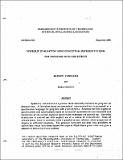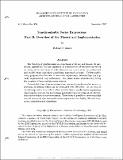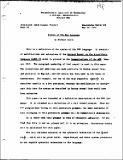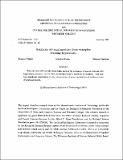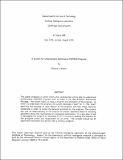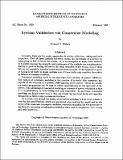Browsing AI Memos (1959 - 2004) by Title
Now showing items 1065-1084 of 1217
-
Surviving the Information Explosion: How People Find Their Electronic Information
(2003-04-15)We report on a study of how people look for information within email, files, and the Web. When locating a document or searching for a specific answer, people relied on their contextual knowledge of their information target ... -
Swimming in Space-Time
(2002-11-01)Cyclic changes in the shape of a quasi-rigid body on a curved manifold can lead to net translation and/or rotation of the body in the manifold. Presuming space-time is a curved manifold as portrayed by general relativity, ... -
Symbolic Construction of a 2D Scale-Space Image
(1988-04-01)The shapes of naturally occurring objects characteristically involve spatial events occurring at many scales. This paper offers a symbolic approach to constructing a primitive shape description across scales for 2D ... -
Symbolic Error Analysis and Robot Planning
(1982-09-01)A program to control a robot manipulator for industrial assembly operations must take into account possible errors in parts placement and tolerances of the parts themselves. Previous approaches to this problem have been ... -
Symbolic Evaluation Using Conceptual Representations for Programs with Side-Effects
(1976-12-01)Symbolic evaluation is a process which abstractly evaluates an program on abstract data. A formalism based on conceptual representations is proposed as a specification language for programs with side-effects. Relations ... -
Symbolic Integration
(1966-06-01)A program has been written which is capable of integrating all but two of the problems solved by the Siagle's symbollic integration program SAINT. In contrast to SAINT, it is a purely algorithmic program and it has ... -
Symbolic Integration II
(1966-10-01)In this memo we describe the current state of the integration program originally described in AI Memo 97 (MAC-M-310). Familiarity with Memo 97 is assumed. Some of the algorithms described in that memo have been extended. ... -
Symmetric Set Theory: A General Theory of Isomorphism, Abstraction, and Representation
(1983-08-01)It is possible to represent a finite set of points (atoms) by a finite sequence of points. However a finite set of points has no distinguished member and therefore it is impossible to define a function which takes a ... -
Synapses That Compute Motion
(1987-06-01)Biophysics of computation is a new field that attempts to characterize the role in information processing of the several biophysical mechanisms in neurons, synapses, and membranes that have been uncovered in recent ... -
Synchronizable Series Expressions: Part II: Overview of the Theory and Implementation
(1987-11-01)The benefits of programming in a functional style are well known. In particular, algorithms that are expressed as compositions of functions operating on series/vectors/streams of data elements are much easier to ... -
Syntactic Closures
(1988-06-01)In this paper we describe {\\it syntactic closures}. Syntactic closures address the scoping problems that arise when writing macros. We discuss some issues raised by introducing syntactic closures into the macro ... -
Syntax and Display of Mathematical Expressions
(1965-07-01)A LISP program converts a mathematical expression stored in list structure form, into a text-book style visual display. To do this, requires the selection and positioning of the individual symbols which make up the expression, ... -
Syntax of the New Language
(1964-05-01)This is a definition of the syntax of the *** language. It consists of modifications and extensions of the "Revised Report on the Algorithmic Language ALGOL 60" which is printed in the "Communications of the ACM", January ... -
The Synthesis of Force-Closure Grasps
(1985-09-01)This paper addresses the problem of synthesizing planar grasps that have force closure. A grasp on an object is a force closure grasp if and only if we can exert, through the set of contacts, arbitrary force and moment on ... -
The Synthesis of Stable Grasps in the Plane
(1985-10-01)This paper addresses the problem of synthesizing stable grasps on arbitrary planar polygons. Each finger is a virtual spring whose stiffnes and compression can be programmed. The contacts between the finger tips and the ... -
Synthesis of Visual Modules from Examples: Learning Hyperacuity
(1991-01-01)Networks that solve specific visual tasks, such as the evaluation of spatial relations with hyperacuity precision, can be eastily synthesized from a small set of examples. This may have significant implications for the ... -
Synthesizing Constraint Expressions
(1976-07-01)An algorithm is presented for determining the values which simultaneously satisfy a set of relations, or constraints, involving different subsets of n variables. The relations are represented in a series of constraint ... -
A System for Understanding Mathematical FORTRAN Programs
(1976-08-01)This paper proposes a system which, when implemented, will be able to understand mathematical FORTRAN programs such as those in the IBM Scientific Subroutine Package. The system takes, as input, a program and annotation ... -
System Validation via Constraint Modeling
(1988-02-01)Constraint modeling could be a very important system validation method, because its abilities are complementary to both testing and code inspection. In particular, even though the ability of constraint modeling to ... -
Systematic Nonlinear Planning
(1991-12-01)This paper presents a simple, sound, complete, and systematic algorithm for domain independent STRIPS planning. Simplicity is achieved by starting with a ground procedure and then applying a general and independently ...




